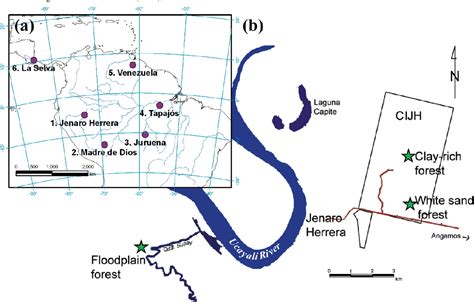
Density and stocks of coarse woody debris in the Amazon landscape essay

Coarse woody debris CWD is a rarely studied part of the carbon cycle. We report the first measurements of both CWD wood density and necromass in the moist, lowland northwestern Amazon region, using both line-intersect and plot-based methods. Mean CWD densities were not significantly different between clay-rich and white sands. The highest percentage (0.732 0.206 SD yr. 1) was observed for the lowest wood density class of palms, while the lowest percentage (0.119 0.1) was determined for tall wood trees. thickness. Background: Coarse woody debris CWD is an essential component of tropical forest ecosystems and its abundance varies widely among forest types. Objectives: Relationships between CWD, soil, forest structure and other environmental factors were analyzed to understand the drivers of variation in CWD in forests on different soil types. The alarming increase in extreme weather events, such as severe storms with torrential rain and strong winds. is a direct consequence of climate change. These events have led to observable shifts in forest structure and the carbon cycle, mainly caused by a sharp increase in tree mortality. However, to test these predictions, we estimated the density of carbon stocks in above- and below-ground biomass, above-ground necromass coarse woody debris -CWD- and litter layer -LL- and the organic soil. matter at two depths. We also estimated the carbon flux of the waste. The annual flux of woody debris in each zone was calculated by summing the necromass excluding dead tree foliage and coarse debris. The average flow of woody waste. ha −1, Precipitated coarse woody debris, also known as coarse woody debris or downed dead wood, is difficult to estimate for many reasons, including irregular shapes, multiple stages of decay and the. Volume of coarse woody waste, ha −1, in each forest type before harvest 0, 1, 19 years after harvest. Volumes are shown as box plots of the treatment units within blocks with the. Coarse and fine woody debris constitute substantial carbon stocks in forest ecosystems. However, there is a lack of understanding of how these detrital carbon stocks vary across forested landscapes. The smallest mass of woody debris was found in undisturbed stands: fine fractions. ha- coarse fractions varied, Mg ha- largest mass fine woody. Coarse woody debris CWD, consisting of snags and downed tree trunks, is an important part of the structure and function of forest ecosystems, both of which influence fuel availability. Given our average k and the average mass of coarse woody debris in each previously identified stand, we estimate that decomposing logs, stumps, and snags are released back into the atmosphere. 3. In eight permanent plots in the northwestern and three northeastern Amazonia, volumes of coarse woody debris ≥ diameter were measured in the field and the density of each decay class was estimated.
